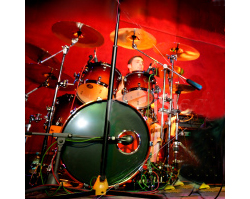Mic’ing drums in a contemporary worship environment is a learned craft and skill that relies on technical know-how, a musical ear, partnership with musicians (and the drummer in particular), favorable acoustics, well-behaved loudspeakers, reasonable financial investment, and lots of patience.
How’s that for mix of encouraging and disheartening words?
The need for sound reinforcement in contemporary worship and gospel music is similar to that in modern pop music (including R&R, R&B, soul, funk, electric folk, etc.), especially where musical content and electroacoustic needs are concerned.
The drum kit’s position in the music and the mic techniques employed are the same as for pop music and, unfortunately, the rather long list of potential problems that can plague sound folk and drummers alike are a good part of this equation.
There are a number of misinformed concepts about drum sound in pop sound reinforcement and these are equally wrong when applied to sound reinforcement in contemporary worship music. Here’s the shortlist of misinformed ideas:
1. In smaller spaces drums do not need to be mic’d – everyone can hear them just fine.
2. For “pure” drum sound you should use a minimalist mic technique consisting perhaps of an overhead (or two for stereo) and a supplemental kick drum mic.
3. Drummers rely on feel and this equates to striking at whatever force they need to
4. If drums are too loud, we can just throw up some absorbing materials and this will really improve things.
5. If drums are too loud we can just buy inexpensive plexiglass shields and this will minimize the volume levels.
6. If the drums are too loud, we can reduce the volume levels with properly designed acoustic gobo’s and then add monitors so the drummer can hear his drums at the volume he/she wants.
7. If the drums are too loud the answer is to buy an electronic set.
Where We Came From
Somewhere during the 1950s-1970s, during rock-pop music’s formative years, a number of practices were developed that shaped how we perceive drums in the music we are discussing.
Virtually all of these mic’ing techniques and their resulting trademark sound were derived in recording studios. Many of them were developed for very good reasons relating to recording technique and some were sheer accidents that someone was savvy enough to recognize as worthwhile and didn’t record over.
The basic aural attributes of the majority of drum sounds that we employ and love are clarity, distinctness, power, and controlled tone with pronounced attack.
In some cases, there have been intentional efforts to minimize one or more of these. (I think back to some of the seminal recordings from the 1970’s-80’s, wherein the drums sound like very well-recorded cardboard boxes – with no tone whatsoever.) But overall these are what we recognize as key ingredients to great drums sounds.
Another fact of life in drum recording and reinforcement is that seldom does the sound that we strive for have much to do with the acoustic sound of the kit. Let me put this another way: Great sounding drums in live sound are completely unreal. They are not natural. Period. What we hear at the kit is not what we want to hear out of the FOH system and it is not what the drummer wants to hear from his monitor, typically.
Now don’t get in a tizzy if you are thinking of jazz drums, ethno-folk, new-age drums or any other musical style in which it is desirable to faithfully “capture” the real sound and reinforce it. That’s not what we’re talking about here.
So much of pop music (think post early Elvis and Little Richard) is distortion, not just in the case of cranked-up guitar but also grossly exaggerated and manipulated vocals, keyboards, saxophones, organ, ambient effects, etc.
Why We Continue In This Fashion
Aside from the musical merits of providing the same “in your face” drum sounds that virtually all popular rockinfluenced music employs to very good effect, there are very good live sound-related reasons to pursue the techniques that we do.
No matter what level you and your church may be on, from the lowest of hodge-podge, hand-me-down, and donated sub-garage band sound systems to the most well-endowed megachurch with unlimited equipment and designer budgets plus technical crews that fell off the last Sting tour, we are all fighting the same live sound battles.
In order to retain good, clear microphone pickup we need to reject the ever-present leakage that permeates every stage and platform under the sun.
To this end we must employ close mic’ing and utilize large amounts of playing and mixing chops to ensure that each drum hit is captured with a minimal amount of noise. ‘Noise’ is employed here just as it is in other instances of signal-to-noise that we in audio always have to deal with.
Each drum that we have so meticulously mic’d and is so wonderfully wacked by the incredible drummer is also a noise source for any and all of the other mics typically employed on a drum kit. This is where musical technique along with audio technique come into play and are of equal value.




















